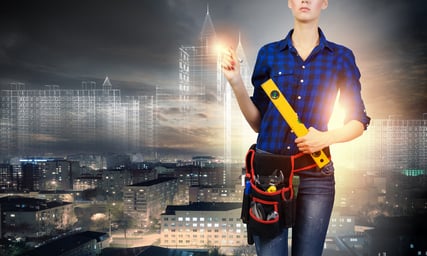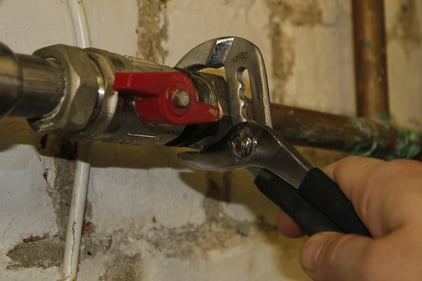
Affordable control of heating, lighting and entry to increase the energy efficiency and simplify maintenance of this commercial building
A smart building's primary task is to maintain the indoor environment to be comfortable for the people in it. Atamate's smart building technology is flexible enough to operate any type of building service and to choose the combination of services that make the building comfortable as energy efficiently as possible. The components communicate using wireless technology, which makes it straightforward to retrofit to an existing building.
This article is part of a series on the benefits of making a building smart using Atamate controls. The other posts are:
Benefits of a smart building 1: Comfort
Benefits of a smart building 3: Safety and management
Our first article in this series described how Atamate makes a building smart and how it keeps the people inside it comfortable. While comfort is the smart building's primary objective, the smart building's hub chooses the most energy-efficient way to maintain that comfort. By cutting bills to below what they would be if the building services were left to manual control, the energy efficiency offsets the cost of making the building smart in the first place.
The more of the building's services that are placed under smart control, the larger the toolbox the system has to achieve a comfortable internal environment so the more efficiently it can operate. For that reason, the most energy-efficient smart buildings are those which were designed from the outset to be smart.
The well-insulated fabric of a modern building allows a smart building to divide the building into zones and regulate the temperature and air quality in each zone. Because the sensors monitor every room separately, they enable the hub to operate services like heating and the ventilation only where  and when it is needed. For instance, a bedroom may be a zone unto itself once its door is closed and if no one is in that room during the day, the hub will not waste energy on maintaining its temperature at a comfortable level.
and when it is needed. For instance, a bedroom may be a zone unto itself once its door is closed and if no one is in that room during the day, the hub will not waste energy on maintaining its temperature at a comfortable level.
A conventional building that was not designed to be airtight is continually ventilated by air flowing through it, so it requires gas-powered central heating to replace the heat energy being lost. Central heating uses water as a conduit to pass heat energy around a building and release it as it passes through radiators or underfloor heating. Because water has a high thermal mass, meaning that it can store a lot of heat energy, it is an efficient way of delivering continuous heating. However, continuous heating requires continuous consumption of energy and a downside of water's high thermal mass is that it takes time to heat it to the desired temperature and it also takes time to cool down if necessary, so the temperature often fluctuates around the thermostat setting.
Modern building standards use fabric that is airtight enough to prevent the constant through-flow of air, allowing central heating to be replaced with infra-red heaters. Occupancy-based control, using the sensor network to detect when someone is in a room, limits the use of the heaters to when someone is in the room.
The more services placed under smart control, the more options the hub has to achieve any given outcome and the more it can avoid different services working against each other.
Keeping a building cool on a hot day can involve several different systems: ventilation driven by an extractor fan, shading, motorised windows and aircon. A single building may have all of those services, and having them all under smart control allows the hub to choose the most energy-efficient way of keeping the temperature comfortable.
Not every smart building has all of those services under its control but the more it has to work with, the more efficiently it can keep its occupants comfortable.

Because a smart building continually monitors its internal environment and the performance of the services it controls, it is often able to detect problems before the occupants notice them. It indicates the problems through the user interface, allowing the maintenance to be performed before a problem can deteriorate. The savings come partly from keeping the services operating at maximum efficiency and partly from limiting the damage that might be caused by the fault.
For example, a leak in a water pipe may cause a buildup of humidity, and it may also cause a fall in the water pressure that requires the water pump to use more energy. Unless the leak is repaired, it is likely to cause mould to grow where the water is leaking while the low pressure is likely to damage the water pump to the point that it needs replacing and may break down completely.
Long before there is any serious damage, the humidity will be detected by air quality sensors and if the water system is under smart control, it will also detect the loss of pressure. The user interface will indicate the problem so that a plumber can be called to repair it.
Atamate's new generation of smart building controls uses Bluetooth to allow wireless communication between the hub, the sensors and the controls. That has substantially improved the potential for retrofitting conventional buildings to be smart b
ecause a major limitation has been the space required for the wiring.
It

is still unlikely that a conventional building retrofitted as a smart building will achieve the same energy efficiency as an equivalent building that was designed from the outset to be smart, but significant savings are still possible.
The more services placed under smart control, the greater the improvements in energy efficiency that can be achieved. However, part of the planning of a retrofit involves balancing the projected savings against both the cost and the level of disruption involved in installation.
William Boot is employed to manage a building that houses the offices of two news websites, the Zincplate and the Copperbottom. The staff of the two websites refuse to talk to each other because they are afraid they will steal each other's stories. In separate meetings, the editors of both sites have complained about the building overheads being too high, but they are willing to contribute renovation costs if they will lead to savings over the longer term.
The building is a Victorian terrace converted into offices with the Zincplate at the east end and the Copperbottom at the west, separated by William's office on the top floor and the shared IT manager's on the ground floor. The building fabric is in a poor state of repair, but neither the Zincplate's nor the Copperbottom's editors will agree to the building being closed for several days while it is renovated.
William's solution is to update the building services and install smart controls. Most of the installation work is done immediately before the Christmas holidays when the building is empty for three days and the heating is turned off.

The staff come back to work dreading their first day back because last year, it took so long for the central heating to warm up that everyone was wearing coats and scarves until lunchtime and then it overshot the thermostat setting so they were all sweating by 3 pm. This year, they are pleasantly surprised to find the building is at a comfortable temperature half an hour after they arrived at work, and then they forget about it because it stayed at the same temperature for the rest of the day.
The staff didn't know that William had replaced the old aircon system with air-to-air heat pumps which switched on as fan heaters as soon as the staff enter their offices. William's projections showed that the central heating was a more efficient way of sustaining heating so the boiler switched on at the same time as the heat pumps, although it was not until midday that the central heating had warmed up enough for the hub to switch off the heat pumps.
The hub uses a proportional integral derivative (PID) algorithm to control the central heating, which moderates the heating of the circulating water before it reaches the thermostat temperature. In practice, that meant that it switched the boiler off before the air temperature reached the set point and did not overheat like it did last year. For the rest of the winter, the PID algorithm keeps the internal temperature within a degree of the setpoint without the uncomfortable and wasteful fluctuations in temperature that have been a feature of working at the Zincplate and the Copperbottom in the past.
After a few months, warmer weather replaces the requirement for heating with a requirement for cooling. There are enough people and electronic equipment packed into the offices to generate a lot of heat and because the building is orientated east-to-west, it absorbs a lot of solar heat through the south-facing facade.
Last summer, William never managed to stop the Zincplate's staff opening their windows while the Copperbottom's staff switched on their aircon. Now that the aircon and the newly motorised windows are both under smart control, the hub can avoid the rivals inadvertently conspiring to waste electricity.
 The hub opens the windows when the temperature reaches 23°C (73°F). When it hits 26°C (43°F) and is still climbing, the windows close and the air-to-air heat pumps engage in aircon mode. It is no longer possible for the aircon to be running in one part of the building while the windows are open in the other, and no one from one website needs to talk to anyone from the other.
The hub opens the windows when the temperature reaches 23°C (73°F). When it hits 26°C (43°F) and is still climbing, the windows close and the air-to-air heat pumps engage in aircon mode. It is no longer possible for the aircon to be running in one part of the building while the windows are open in the other, and no one from one website needs to talk to anyone from the other.
Having set the temperature parameters, William only pays attention to the cooling system when the user interface warns him that one of the units is needing to running for longer than it should, meaning that it's time to clean the dust filter.
The energy bills are now noticeably lower and the editors of both the Zincplate and the Copperbottom have stopped complaining about them. Neither of them has thanked William.
Our next post on the benefits of smart buildings focuses on building management and security.
If you would like more information on how smart buildings work or how Atamate controls might benefit you, please fill in the form below and we'll be happy to answer.

Affordable control of heating, lighting and entry to increase the energy efficiency and simplify maintenance of this commercial building

Atamate's smart building controls use the technology of the internet of things to keep a building safe and secure and to simplify the management of multi-use buildings....